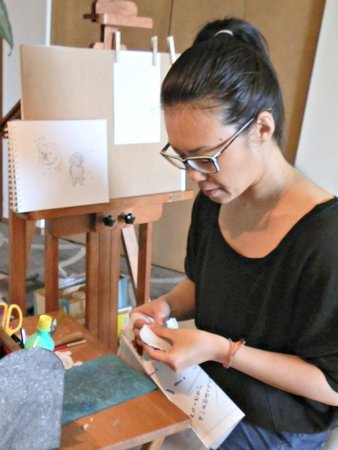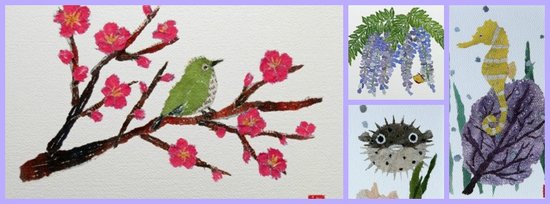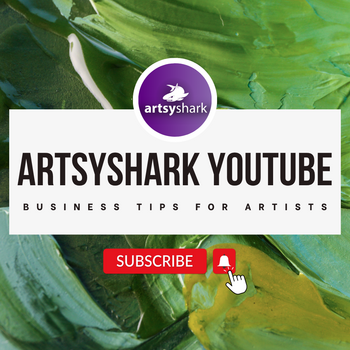by Carolyn Edlund
Seattle-based artist Keiko Suzuki faced frustrating challenges in her business, but was determined to find solutions. Here’s how she made some major changes that are helping move toward her goals.

Keiko Suzuki with work in progress.
After learning a collage technique that creates soft textural images from torn pieces of newspaper, Suzuki started working on her portfolio and had a substantial number of pieces completed. Her goal was to sell her art, but she was unsure just how to do it.
What she did know was that she needed a website, a place to sell online, and a hands-on approach to social media. Starting out on Etsy, she created a storefront. Next, she worked with a webmaster to build her own site with a shopping cart.
Suzuki jumped right in on social media and started a blog, Facebook page, Pinterest boards, and social media profiles.
But then she ran into some challenges. “I had been focusing on using social media updating and advertising that only provided me micro-exposure,” she admits, and “I had no idea how to find the market where my artwork fits in.”
After realizing that face-to-face contact with the public would give her feedback that she needed to identify her target customers, Suzuki decided to get involved with art fairs in her area, and also sell at a summer marketplace on an ongoing basis. She found opportunities by searching Art Fair Calendar, and chose a variety of venues to test market her art.
She will use these opportunities to do some retail research, finding out who responds to her work, questions and suggestions that customers have, and objections that she must overcome to close the sale. There is nothing like in-person contact to learn how to relate to your audience, how to tell your story, and how to connect emotionally with buyers.

Keiko Suzuki creates torn paper collages with nature themes.
Next, there was an issue with her prices, which were too high and stalling sales. Wanting to sell reproductions of her work, Suzuki contacted a printer and got pricing for giclee reproductions on canvas. They advised to triple her cost to price her work at retail. But that formula put her pricing out of sync with similar prints on the market. She says, “I had to set high prices on my art reproductions due to my lack of knowledge in sourcing them in a cost effective way.”
First, she posted a question in her Etsy group, where it was suggested that she buy a printer and do it herself. She then obtained quotes from commercial vendors, and ended up finding some great pricing at Cat Print on a short run of prints on watercolor paper. She also sourced mats on Amazon that worked well for her. In the end, her costs were so reasonable that she is now able to price matted 8” x 10” prints at $20.00 retail and make a very good profit.
Lastly, she dealt with problems that had surfaced with her website content. “I am a non-native English speaker, and writing detailed information about my artwork with enticing expression was extremely challenging,” Suzuki explains.
But getting help was not difficult at all. She sourced some assistance on Fiverr and found a writer who helped create descriptions that not only read more easily, but also convey her Japanese heritage and approach to her artwork.
What are Keiko Suzuki’s biggest assets? Her persistence and her work ethic. She is willing to do whatever it takes to overcome her challenges as they come up. Creating a business as an artist is always a work in progress. Identifying your biggest roadblocks, doing your research and trying out new strategies can make a huge difference in your results.




Hi Carolyn,
Thank you for another helpful article. Please pass on to Keiko Suzuki that given the charm of her imagery and technique she may find a strong market for her work in illustrating children’s books!
http://www.artsyshark.com/2011/03/18/do-you-want-to-be-a-childrens-book-illustrator/
Hi James,
Thank you very much for your sweet comment and advice! I will definitely consider children’s book industry.
Keiko
Thank you Keiko for posting your experiences with marketing and selling your artwork. I have days where I start to feel a little discouraged but I know I can’t give up because this is what I was meant to do, make art.
You’ve given good tips and supply sources that will be helpful to me.
Thanks again.
Sandy Mileski
Hi Sandy,
I too feel kind of discouraged sometimes. Any challenge should come to us as a disguise of an opportunity to a stepping stone to success – this belief that I learned from many books keeps me want to stay and move forward 🙂 Also having a great mentor really helps. (In my case, it is Carolyn. She really helped me a lot.) Lastly, the sources are my go-to and I am happy to hear those would come in handy for you too.
Let’s keep going!!!
Keiko
A good idea!